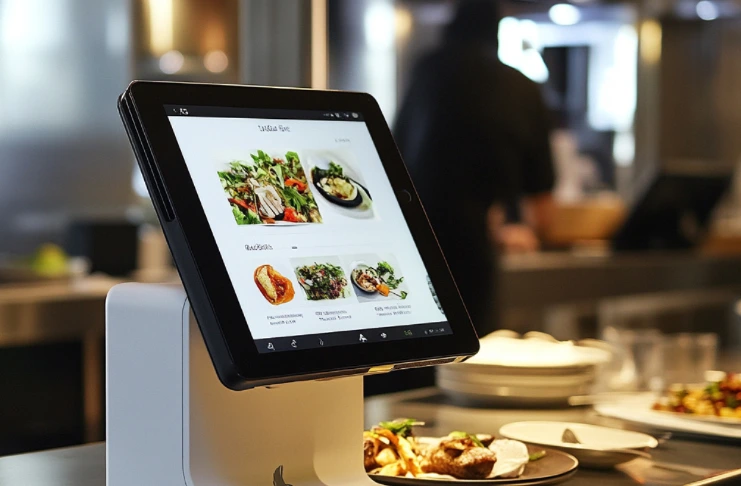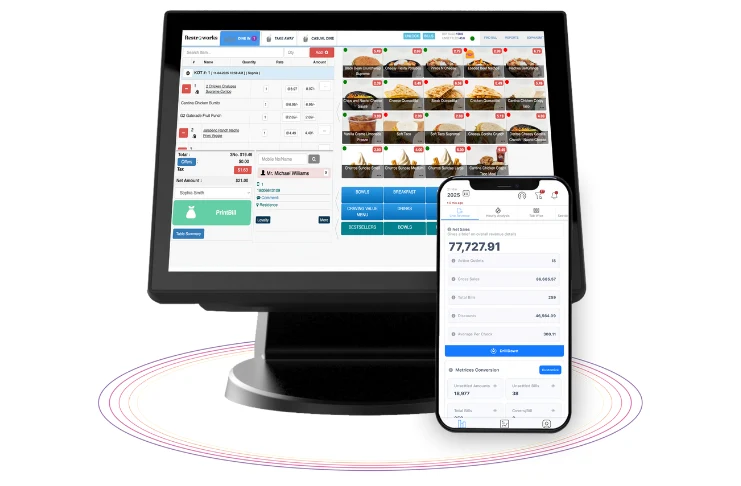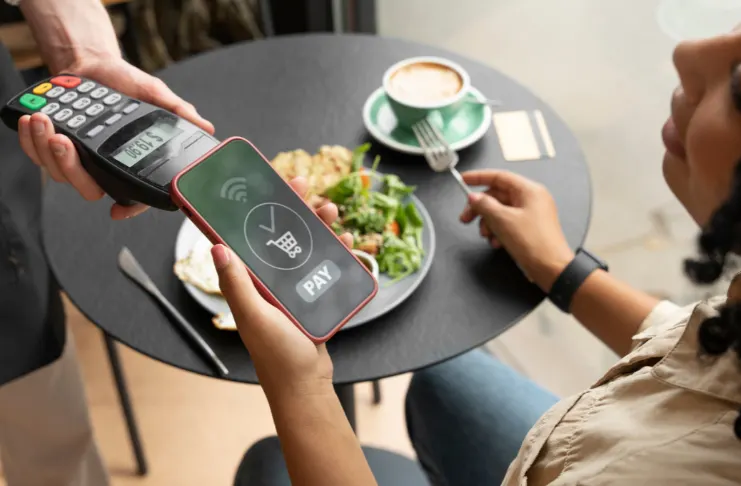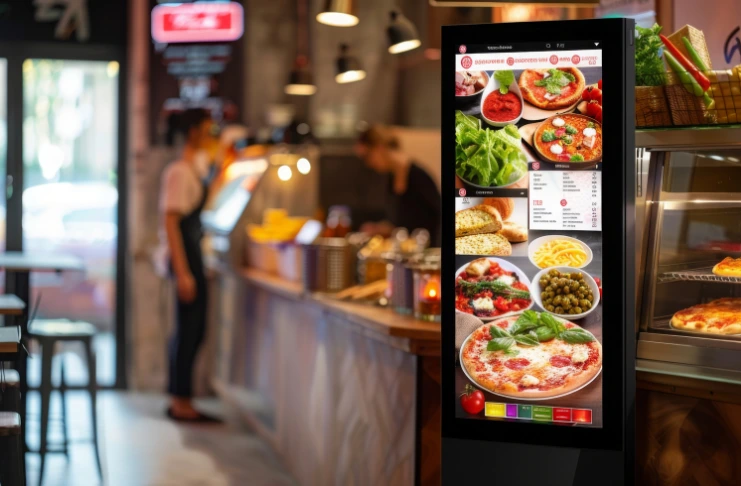
Restaurants are running leaner, faster, and more data-driven than ever. Guests expect contactless payments, quick table turns, accurate orders, and seamless takeout. Operators need tools that help them streamline operations, deliver a great customer experience, and expand to multiple locations without heavy hardware footprints. That is why a modern restaurant POS system, designed around tablets, is now the default choice rather than a novelty.
Whether you’re a full-service restaurant, a food truck, or a mid-sized restaurant with multiple locations, selecting the best POS system is crucial for streamlining operations and staying competitive. This guide examines the top tablet POS systems for restaurants in 2025, highlights key features to consider, and provides guidance on selecting the right solution for your business.
Key Takeaways
- Tablet POS systems are now essential, offering speed, flexibility, and cost efficiency by replacing bulky legacy terminals and enabling mobility across front- and back-of-house operations.
- Customer expectations drive adoption: Contactless payments, quick order turnaround, seamless takeout, and unified online ordering make mobile POS platforms a necessity rather than an upgrade.
- Operational efficiency improves significantly: Centralized menus, recipe-level inventory tracking, real-time reporting, and built-in marketing tools help streamline operations and support growth across multiple locations.
- Scalability and integration are critical: Modern systems support expansion by standardizing workflows, integrating with accounting and delivery platforms, and enabling easy rollouts to new outlets.
- Successful implementation requires planning, including defining workflows, testing live environments, training staff, and monitoring performance over the first 21 days, which ensures a smooth go-live and long-term efficiency.
What is a Tablet POS system?
A tablet POS is a point-of-sale solution that primarily runs on tablets and lightweight POS terminals, often connected to the cloud. It replaces bulky legacy stations with portable devices for servers, cashiers, and floor managers. For a full-service restaurant, that mobility unlocks table-side ordering and faster payments. For small businesses and mobile operations, such as food trucks and pop-ups, it provides enterprise-grade capabilities without the associated overhead.
Good tablet platforms bundle order capture, table management, menu and inventory management, receipts, refunds, basic CRM, and online ordering integrations. They also address payment processing fees, tax handling, cashier controls, and shift reports. The best options layer in marketing tools, loyalty, and detailed analytics, so teams can process payments quickly and make smarter decisions simultaneously.
Key Benefits:
- Portability: Staff can take orders and process payments anywhere in the restaurant.
- Cost-Effectiveness: Lower hardware costs compared to traditional POS systems.
- Easy Updates: Cloud-based systems receive automatic software updates.
- Faster Service: Reduces wait times and improves table management.
- Seamless Integrations: Connects with online ordering platforms, marketing tools, and accounting software.
Why Restaurants are Switching to Tablet POS Solution
- Contactless and wallets are mainstream. Consumers continue to gravitate to tap-to-pay and mobile wallets, and operators have invested heavily in mobile payment tech.
- Off-premise demand is durable. Delivery and takeout usage remains high, and diners frequently place orders through apps or websites.
- mPOS economics are attractive. The mPOS market and tablet POS adoption keep rising, helped by lower upfront costs and faster deployments than legacy systems.
- Processing costs are transparent. Most restaurants plan around processing fees in the 1.5%–3.5% range and optimize menus and channels accordingly.
A modern restaurant pos built for tablets supports online ordering, speeds payments, and centralizes menus and key features across multiple locations. That combination enhances the customer experience and enables teams to streamline their operations on a daily basis.
INDUSTRY INSIGHTS
The National Restaurant Association projects that U.S. restaurant and foodservice sales will reach approximately $1.5 trillion by 2025, underscoring both the opportunity and the operational pressure to modernize.
At the same time, contactless payments continue to surge, with one market report estimating the global contactless market will rise from $57.85B in 2024 to $69.7B in 2025.
On the mobility side, the mobile POS terminals market is on a strong growth curve, expected to more than double from 2022 levels by 2030.
Put simply: mobility, speed, and flexibility win. A thoughtful pos system for restaurants that runs on tablets gives table-side ordering, faster payment options, real-time data, and an easier path to scale.
How to Evaluate the Best Tablet POS for Your Restaurant
Use this simple, practical rubric to shortlist the best restaurant pos system for your concept.
A. Front-of-house operations
- Table management: Build floor plans quickly. Open, seat, transfer, split, or merge checks. See covers, table status, and turn times at a glance.
- Order flow: Modifiers and coursing should be fast. For a full-service restaurant, check seat-level firing, item holds, and server routing.
- Payments: Tap, chip, PIN, QR, and wallet support. Evaluate processing fees by channel and terminal type.
B. Kitchen and production
- KDS / printers: Routing by station, auto-bump, expo views, and clear void/redo handling.
- Firing logic: Timers, cook times, and chit consolidation.
- Stability: Offline order queueing and local print failover.
C. Menus, inventory, and pricing
- Inventory management tools: Recipe-level depletion, purchase units vs. sell units, yields, and variance.
- Menu ops: Dayparts, combos, pricing rules, and availability across multiple locations.
- Online ordering: Native or integrated tools with consistent menus and taxes.
D. Reporting and control
- Analytics: Sales mix, voids, comps, promo ROI, processing fees by tender, labor vs. sales, multi-unit dashboards.
- Security: Roles, approvals, and audit trails.
- Scalability: Easy rollouts to more pos terminals and new outlets.
E. Ecosystem and total cost
- Integrations: Accounting, delivery marketplaces, loyalty, gift cards, and marketing tools.
- Hardware: Rugged tablets, stands, printers, scanners, and payment readers for mobile pos systems.
- Total cost: Subscription tiers, payment processing fees, add-on modules, and support SLAs.
Best Tablet POS System for Restaurants in 2025
Here’s a curated list of the best POS systems for restaurants in 2025, each offering unique strengths for different business types.
POS System | Overview | Best For | Key Features | Pros | Cons |
Restroworks | Unified, cloud-based restaurant POS system with end-to-end modules for FOH, BOH, inventory, and digital ordering. | Multi-outlet brands, enterprise chains, and full-service restaurants | Advanced table management, recipe-level inventory management, online ordering, analytics, and integrations | Hardware-agnostic, deep features, scalable globally, excellent reporting | Premium pricing and requires onboarding |
Toast | Restaurant-centric point of sale with strong kitchen display, payments, and menu operations. | Mid-sized restaurants, bars, QSRs | KDS, menu & order management, loyalty, delivery tools, analytics | Integrated stack, strong reporting, easy-to-use | Primarily US-focused, hardware is often proprietary |
Oracle / MICROS / Simphony | Enterprise-level POS with global compliance, deep configuration, and powerful analytics. | Hotels, resorts, and large full-service restaurant chains | Multi-location control, complex routing, global payments, enterprise analytics | Most scalable, advanced governance, deep customization | Expensive, complex to deploy |
eZee Optimus | Cloud POS built for restaurants with tablet-first workflows and strong menu tools. | Small businesses, regional chains | Order & table management, menu setup, inventory management, reports, online ordering | Cost-effective, quick setup, scalable | Less advanced analytics than enterprise tools |
Square POS for Restaurants | Simple, fast-deploy mobile POS with built-in payments and digital ordering. | Small businesses, pop-ups, food trucks | Quick setup, inventory, online ordering, loyalty, analytics | Very easy to use, scalable add-ons, strong ecosystem | Limited enterprise features |
Lightspeed | Feature-rich POS with detailed reporting, menu engineering, and omnichannel tools. | Mid-sized restaurants, growing chains | Advanced reporting, multi-unit control, inventory management, and online ordering | Strong analytics, custom workflows, scalable | Slightly steeper learning curve |
Shopify POS | A commerce-first POS ideal for hybrid food and retail operations. | Cafés, bakeries, and restaurants selling merchandise | Unified catalog, eCommerce sync, apps for table management, omnichannel tools | Great for hybrid models, large app ecosystem | Requires third-party delivery apps for restaurant-specific needs |
Loyverse POS | Lightweight, budget-friendly POS with core restaurant functionality. | Small businesses, cafés, kiosks | Built-in table management, kitchen printing, loyalty, and basic inventory | Quick to deploy, offline mode, low-cost | Limited advanced features, fewer integrations |
SlickPOS | Cloud POS with simple workflows and quick deployments. | Owner-operator restaurants, mid-sized restaurants | Menu editing, order management, inventory management, and online ordering | Fast setup, practical reporting, and integrations | Less suited for large enterprises |
PayPal Zettle | Payments-first POS with lightweight order and sales tools. | Mobile businesses, seasonal venues | Quick setup, integrated payments, product catalog, reporting | Very easy to deploy, minimal hardware cost | Limited features, basic functionality only |
1. Restroworks

Restroworks is a unified, cloud-first restaurant POS system built for modern operators who need consistency, control, and speed across multiple locations. It’s hardware-agnostic (runs on iOS/Android tablets and standard peripherals), so brands can standardize processes without being locked into proprietary terminals.
The platform combines front-of-house agility (fast ordering, table management, payments) with back-office rigor (inventory management, recipes, purchasing, and advanced reporting), plus digital ordering rails (web, app, QR, kiosks). The result is a single operational backbone that helps teams streamline operations while protecting the guest customer experience.
Key Features
- FOH & Table Service: Visual floor plans, seat-level ordering, splits/transfers, fire/hold, course management, and tip workflows.
- Kitchen & Production: KDS with station routing, timers, bump/recall, expo views, and printer failover for resilience.
- Menu & Inventory: Centralized menus, dayparts, pricing rules, modifiers; recipe-level depletion, par levels, vendor catalogs, GRN, variance.
- Digital Ordering: Native online ordering, QR menus, self-service kiosks, aggregator integrations, order throttling, and promise-time controls.
- Payments & Fees: Multiple tenders (tap/chip/QR/wallets), surcharge rules, and transparent processing fees reporting.
- Analytics & Control: Multi-unit dashboards, sales mix, promo/void audits, outlet benchmarking, and role-based approvals.
- Extensibility: Open integrations (accounting, loyalty/CRM, delivery, marketing) and robust APIs.
Best For
- Full-service restaurant groups, fast-casual chains, and mid-sized restaurants are expanding to new markets.
- Brands seeking a single platform for dine-in, takeaway, delivery, and kiosks without juggling point solutions.
Deployment & Ops Criteria
- Scalability: Rapid rollouts, templated outlet provisioning, centralized governance.
- Hardware Flexibility: Choose tablets and pos terminals that fit the budget and environment.
- Training & Usability: Intuitive workflows reduce onboarding time and errors.
- Total Cost Visibility: Clear subscriptions, add-ons, and payment processing fees help maintain margin discipline.
2. Toast
Toast POS is a leading restaurant POS system purpose-built for the restaurant industry. Unlike generic point-of-sale tools, Toast is designed from the ground up to meet the dynamic needs of restaurants, from high-volume quick-service counters to complex full-service restaurant environments. Its cloud-based platform runs seamlessly on tablets, handheld devices, and countertop POS terminals, providing operators with flexibility and speed in both front-of-house and back-of-house workflows.
Key Features
- Order & Table Management: Table-side ordering, seat-level firing, check splitting, transfers, and real-time order status.
- Kitchen Display System (KDS): Automated order routing, course timing, and bump screens to streamline operations and reduce errors.
- Payment Flexibility: Accepts cards, tap-to-pay, mobile wallets, and contactless payments with transparent payment processing fees.
- Digital Tools: Integrated online ordering, delivery dispatch, loyalty programs, gift cards, and marketing tools to boost repeat business.
- Advanced Reporting: Sales analytics, labor reports, menu performance insights, and multi-location dashboards.
Best For
- Mid-sized restaurants seeking an integrated mobile POS solution.
- Operators who want an all-in-one platform that combines front-of-house, back-of-house, and digital channels.
- Mobile businesses and pop-ups need reliable, tablet-friendly POS hardware.
Additional Criteria
- Scalability: Ideal for growing brands expanding to multiple locations.
- Support & Training: Extensive onboarding, 24/7 support, and staff-friendly UI.
- Cost Control: Clear visibility into processing fees and performance metrics to optimize margins.
3. Oracle / MICROS / Simphony
Designed for enterprise-grade reliability and flexibility, Oracle MICROS Simphony excels in environments where governance, compliance, global consistency, and advanced configuration are mission-critical. Its cloud-based POS platform is widely used by hotels, resorts, cruise lines, and multinational full-service restaurant chains, offering unmatched scalability and operational depth.
Key Features
- Inventory & Menu Management: Centralized menu publishing, recipe costing, ingredient tracking, and multi-store stock control.
- Global Scalability: Centralized governance for pricing, promotions, and compliance across regions and multiple locations.
- Integrated Payments: Support for global tender types, currency handling, and transparent payment processing fees.
- Analytics & Insights: Enterprise-level dashboards, predictive analytics, labor optimization, and location benchmarking.
- Integrations: Deep links with Oracle Hospitality, CRM, loyalty, HR, and marketing tools for a complete tech ecosystem.
Best For
- Large, complex full-service restaurant groups with layered menus and high daily transaction volumes.
- Hotels, resorts, cruise lines, and global F&B brands need strict compliance and centralized control.
- Operators are scaling rapidly across countries or regions.
Additional Criteria
- Scalability: Robust architecture for thousands of POS terminals across global outlets.
- Reliability: Enterprise-grade uptime, security, and support.
- Customization: Deep configuration options for unique service workflows and menu structures.
4. eZee Optimus
eZee Optimus is a powerful cloud-based restaurant POS software designed to simplify daily operations for restaurants of all sizes, from small cafés and quick service restaurants to regional chains and mid-sized restaurants. Known for its intuitive tablet-based workflows, Optimus supports dine-in, takeaway, delivery, and catering from a single platform.
Its flexible, hardware-agnostic design helps operators transition away from costly legacy servers while maintaining full control over menus, orders, payments, and inventory. With a strong focus on usability, affordability, and scalability, eZee Optimus helps businesses streamline operations and deliver a seamless customer experience.
Key Features
- Inventory Management Features: Track stock levels, automate purchase cycles, manage suppliers, and monitor wastage to improve profitability.
- Multi-Channel Ordering: Built-in online ordering tools with aggregator integrations for delivery platforms.
- Payments & Fees: Flexible payment options, digital wallets, and clear visibility into payment processing fees.
- Reporting & Analytics: Sales summaries, item-level reports, outlet comparisons, and business insights for smarter decision-making.
- Marketing Tools: Loyalty programs, promotions, and customer engagement modules to increase repeat visits.
Best For
- Small businesses and mid-sized restaurants are looking for a budget-friendly yet robust POS solution.
- Regional chains are seeking to standardize operations across multiple locations.
- Restaurants are upgrading from legacy on-premise systems to cloud-based mobile POS platforms.
Additional Criteria
- Scalability: Easily expandable as the business grows.
- Affordability: Low hardware and setup costs.
- Ease of Use: Intuitive interface reduces training time.
5. Square
Square for Restaurants is a flexible, user-friendly restaurant POS system designed for simplicity, speed, and scalability. Known for its quick setup, clean interface, and minimal hardware requirements, it’s one of the most accessible solutions for new and growing businesses. Square combines powerful point-of-sale tools with built-in payments, online ordering, and a wide range of third-party integrations, making it an ideal choice for small businesses, pop-ups, food trucks, cafes, and hybrid operations.
Key Features
- Quick Setup & Easy Use: An intuitive dashboard and drag-and-drop menu builder enable rapid deployment with minimal IT support requirements.
- Integrated Payments: Accepts cards, digital wallets, tap-to-pay, and QR payments with transparent payment processing fees.
- Online Ordering: Built-in ordering site and delivery integrations to manage in-store and digital sales from one system.
- Marketing & Loyalty: Built-in marketing tools, email campaigns, and loyalty programs to boost retention.
- Analytics & Reporting: Sales insights, menu performance, employee tracking, and business growth dashboards.
Best For
- Mobile businesses like food trucks, pop-ups, and kiosks.
- Small businesses launching their first POS or expanding digital ordering.
- Hybrid models sell both in-person and online.
Additional Criteria
- Scalability: Add advanced features as your business grows.
- Affordability: Low upfront hardware costs and simple pricing.
- Multi-Location Ready: Easily expand to multiple locations with centralized management.
6. Lightspeed

Known for its robust analytics, advanced menu management, and strong multi-unit capabilities, Lightspeed is ideal for growing brands, mid-sized restaurants, and hospitality groups looking to scale across multiple locations.
The platform combines front-of-house efficiency, back-office automation, and omnichannel capabilities, including online ordering and delivery integrations, to help restaurants streamline operations and deliver a seamless customer experience.
With its highly customizable workflows and enterprise-grade tools, Lightspeed provides the flexibility to adapt to evolving service models and operational needs.
Key Features
- Inventory Management: Real-time stock tracking, recipe costing, vendor management, and automated purchasing workflows.
- Powerful Analytics & Reporting: Detailed dashboards, sales performance tracking, channel comparisons, and item-level profitability insights.
- Omnichannel Tools: Integrated online ordering, delivery partner connections, and customer engagement features.
- Payment Processing: Secure transactions with transparent payment processing fees, supporting cards, wallets, and contactless options.
- Integrations & Add-ons: Compatible with loyalty, CRM, accounting, and marketing tools to extend functionality.
Best For
- Mid-sized restaurants and growing brands are expanding to multiple locations.
- Operators need deeper insights into performance and tighter control over costs.
- Businesses focused on omnichannel growth and enhanced guest experiences.
Additional Criteria
- Scalability: Easily scales from single-unit to enterprise-level operations.
- Customization: Flexible workflows tailored to specific service styles.
- Support: Comprehensive onboarding, training, and 24/7 support.
7. Shopify POS
Shopify POS is a versatile restaurant POS system designed for businesses that operate at the intersection of food service, retail, and e-commerce. While it may not offer all the native features of traditional restaurant platforms, its strength lies in its unified product catalog, omnichannel selling capabilities, and seamless integration with Shopify’s global commerce ecosystem. This makes it an excellent choice for restaurants, cafés, bakeries, or specialty food brands that also sell merchandise, packaged goods, or online meal kits.
Key Features
- Omnichannel Selling: Sell in-store, online, and via social media, all synced through one platform.
- Integrated Payments: Accept cards, wallets, and contactless payments with transparent payment processing fees.
- Customizable POS: Add table management, menu tools, and kitchen routing via apps and third-party integrations.
- Customer Engagement: Built-in loyalty, gift cards, email marketing, and upselling features.
- Advanced Reporting: Real-time analytics on sales, traffic, customer behavior, and product performance.
- Online Ordering & Delivery: Easy setup for pickup, delivery, and local fulfillment.
Best For
- Restaurants or cafés with significant retail or eCommerce components.
- Brands selling packaged goods, merchandise, or subscriptions alongside food.
- Small businesses or mobile businesses are looking for a unified commerce platform.
Additional Criteria
- Scalability: Ideal for businesses planning omnichannel growth.
- Ecosystem: Extensive app marketplace and third-party marketing tools.
- Ease of Use: Quick onboarding and intuitive workflows.
8. Loyverse
Loyverse POS is a lightweight, easy-to-use, and budget-friendly restaurant POS system designed for simplicity and quick deployment. It’s an excellent option for cafés, food trucks, small eateries, and first-time operators who need essential POS functionality without the complexity or cost of enterprise-grade platforms.
Despite its minimalist approach, Loyverse covers all the core requirements from table management and ticket handling to kitchen printing and sales analytics, while offering optional paid add-ons for advanced capabilities.
Key Features
- Kitchen Display & Printing: Real-time order routing to the kitchen and support for multiple printers.
- Customer Engagement: Built-in loyalty program, customer database, and sales insights to improve retention.
- Payment Processing: Flexible options for cash, cards, and mobile wallets with transparent payment processing fees.
- Analytics & Reporting: Detailed sales reports, product performance insights, and daily summaries.
- Multi-Location Support: Manage multiple outlets from a single, centralized dashboard as your business expands.
- Integration Options: Connect with accounting, eCommerce, and online ordering platforms via third-party apps.
Best For
- Small businesses and startups are launching their first POS system.
- Mobile businesses such as food trucks, kiosks, and pop-ups.
- Operators focused on simplicity, affordability, and speed.
Additional Criteria
- Affordability: Core features are free; premium add-ons are available.
- Ease of Use: Minimal training required for staff.
- Scalability: Grows with your business as needs evolve.
9. SlickPOS
SlickPOS is a modern, cloud-based restaurant POS system designed to deliver simplicity, speed, and flexibility for restaurants that want powerful functionality without the complexity of enterprise platforms. Built around clean tablet-based workflows, it helps teams streamline operations with intuitive order-taking, quick menu updates, and seamless integrations, making it a great choice for owner-operated venues, cafés, and mid-sized restaurants.
Key Features
- Order & Table Management: Simple order workflows, table tracking, check splitting, and ticket transfers for dine-in and takeaway.
- Online Ordering: Built-in ordering platform plus third-party delivery integrations to expand sales channels.
- Payments & Fees: Flexible payment acceptance with clear visibility into payment processing fees and transaction history.
- Analytics & Reporting: Detailed reports on sales, staff performance, item popularity, and revenue trends.
- Integrations: Connect with accounting tools, loyalty programs, and marketing tools for a more complete tech stack.
- Multi-Location Ready: Manage multiple outlets and standardize operations from a single dashboard.
Best For
- Independent restaurants and cafés seeking a simple yet scalable POS.
- Mid-sized restaurants need reliable multi-channel operations.
- Businesses are rolling out a handful of POS terminals without heavy IT involvement.
Additional Criteria
- Ease of Deployment: Quick setup and minimal training required.
- Affordability: Lower upfront and subscription costs make a POS system more affordable.
- Scalability: Easily grows with expanding locations and menus.
10. PayPal Zettle
PayPal Zettle POS is a payments-first restaurant POS system designed for simplicity, mobility, and affordability. It offers a lightweight POS layer built on top of PayPal’s powerful payment infrastructure, making it an ideal solution for businesses with straightforward operational needs.
Whether you’re running a food truck, kiosk, pop-up stand, or seasonal café, Zettle provides all the essentials from order management and sales tracking to integrated payments, without the complexity or cost of enterprise-grade solutions.
Key Features
- Simple Setup & Interface: Quick deployment on tablets and smartphones with no heavy onboarding required.
- Basic POS Tools: Lightweight order management, product catalog, discounts, and receipt printing.
- Mobile Flexibility: Works anywhere with internet access, ideal for outdoor dining, markets, and events.
- Inventory & Reporting: Track products, monitor stock, and generate sales reports from a centralized dashboard.
- Customer Experience: Fast checkout and payment options enhance convenience for guests.
- Third-Party Integrations: Connect with online ordering tools, accounting software, and marketing tools for added functionality.
Best For
- Mobile businesses include food trucks, stalls, pop-ups, and seasonal venues.
- Small businesses are seeking a cost-effective way to process payments.
- Operators needing a secondary POS for patio service, events, or overflow stations.
Additional Criteria
- Affordability: Minimal upfront costs and pay-as-you-go pricing.
- Ease of Use: Intuitive UI with virtually no learning curve.
- Scalability: Best suited for small-scale operations or as a supplemental POS.
How Restaurant Operators Choose the Right POS

Use this quick lens to choose the right pos system for your restaurant:
- Service style fit
- Full-service restaurant: Deep table management, seat-level coursing, KDS logic, and sophisticated comp/void control.
- Counter service and pop-ups: Speed, simple menus, flexible tendering, and robust mobile pos systems for outdoor or high-traffic events.
- Scale and control
- Single units/small businesses: Favor ease of use, low setup friction, and predictable processing fees.
- Multiple locations/mid-sized restaurants: Central menu publishing, enterprise reporting, store-level guardrails, and efficient rollouts to numerous POS terminals.
- Commerce mix
- If online ordering is significant, insist on a unified menu and taxes across all channels and kitchens, as well as clear and consistent promise times.
- Back-office depth
- If food cost is a crucial factor, choose systems with recipe-level inventory management and vendor integration, allowing you to identify waste and variance.
Key Tablet POS Features That Matter in 2025
A. Table management and floor control
You want a living map of your dining room. Staff should be able to open and seat, transfer checks, split bills, and check course status without having to hunt through screens. Add table-side pay with mobile pos card readers to cut turn times and improve customer service. For large patios or private dining rooms, mapping tables to sections helps you streamline operations and maintain server balance.
B. Kitchen Display Systems (KDS) and routing
Accurate routing removes chaos. KDS should support item consolidation, auto-bump, expo review, and re-fires. When online ordering spikes, effective throttling prevents long queues while maintaining accurate quotes. In a full-service restaurant, seat-level firing and timing rules ensure that hot food remains hot.
C. Inventory management and recipes
Real control starts with recipes and pack sizes. Look for par levels, vendor catalogs, depletion per item, and real-time variance. If you run multiple locations, centralized items and recipes keep counts consistent, allowing managers to handle local substitutions. This is where the best restaurant pos system pays for itself.
D. Payments and fees
Support tap, chip, QR, and wallets. Track payment processing fees by tender to understand profitability by channel. In most markets, restaurants see roughly 1.5%–3.5% card fees before other costs. Transparent reporting enables you to optimize routing for lower-cost rails without compromising the customer experience.
E. Data, reporting, and marketing tools
Actionable reporting should surface sales mix, voids, comps, and server performance without spreadsheet gymnastics. Add marketing tools for email, SMS, or loyalty to drive repeat visits. Tie promos to KDS rules to maintain kitchen flow and streamline operations during peaks.
F. Online ordering and channels
Ensure the POS is the source of truth for menu, pricing, and tax. Third-party marketplaces can supplement your branded online ordering, but they should be fast, reliable, and integrated to minimize errors. Delivery demand remains meaningful across markets, so treat this like a core workflow rather than an add-on.
Find the Best POS for Your Restaurant Concept

- Independent full-service with reservations and bar:
Select the best tablet POS system with advanced table management, comprehensive KDS rules, and recipe-level cost control. Restroworks, Lightspeed, or Simphony often fit. - Busy counter-service with heavy takeout:
Favor mobile pos systems with very fast order entry, simple menus, and dependable online ordering. Restroworks, SlickPOS, Toast, or Loyverse are common picks. - Multi-unit casual group scaling to new cities:
Look for centralized menu control, outlet rollouts, and a strong integration layer for accounting and delivery. Restroworks, Simphony, and Lightspeed stand out for their support of multi-location restaurants. - Hybrid retail + restaurant concept:
Shopify POS shines when retail SKUs and eCommerce matter. Augment with FOH apps for table management and kitchen routing, or choose a restaurant-first platform with retail integrations.
Pricing, Processing, and Total Cost

When comparing the best pos system options, compute a realistic 12- to 36-month view:
- Subscriptions: Core POS licenses, add-ons for inventory management, KDS, loyalty, or marketing tools.
- Payment processing fees: Expect a band around ~1.5%–3.5%, varying by card, contract, and plan. Track net effective rates, not only headline rates.
- Hardware: Tablets, stands, readers, and receipt printers. Plan for extra pos terminals during peaks or patios.
- Setup and training: Time savings matter. Faster adoption reduces errors and protects the customer experience.
- Support: Extended hours and on-site options can pay for themselves, especially at peak times.
How to Implement Your POS Smoothly
Implementing a new restaurant POS system can feel overwhelming, but a structured approach ensures a smooth launch and long-term success. Here’s how to do it step by step.
- Define service scenarios. Start by mapping out all service workflows: dine-in, bar, takeout, delivery, and catering. Each has unique operational needs that influence your table management setup, menu structure, KDS routing, and printer configurations. This clarity helps you design the POS environment around real-world usage, reducing errors and confusion later.
- Build the single source of truth. Centralize all key data, including menu items, recipes, modifiers, taxes, and discounts, in a single system. This ensures consistency across channels, especially for online ordering, where customers should see the same pricing, availability, and item details as they do in-store. A unified catalog also simplifies updates and reporting.
- Pilot on a live shift. Before a full rollout, run a live test during actual service hours. Monitor how mobile POS devices hand off orders, how printers and kitchen displays function, and whether payment options (such as card dips, taps, or QR codes) process smoothly. Early testing prevents disruptions during busy periods.
- Train and certify staff. Effective training is critical. Keep sessions focused on the 8–10 most common tasks: taking orders, splitting checks, issuing refunds, and processing payments. Confidence at the front line means fewer mistakes and faster service.
- Measure the first 21 days. Track performance metrics like ticket times, voids, comps, and payment processing fees. Address issues quickly to maintain a strong customer experience and streamline operations.
- Scale to multiple locations. Once the setup is stable, replicate it across multiple locations. Standardize menus, reports, and workflows so every unit operates from the same playbook, ensuring consistency, efficiency, and easier long-term management.
Conclusion
In 2025, tablet POS systems are revolutionizing the way restaurants operate, bringing speed, flexibility, and mobility to the heart of food service. Whether you’re managing a bustling dine-in space or a fast-paced food truck, mobile-friendly POS solutions provide the agility to serve customers more effectively, track inventory in real-time, and adapt quickly to changing business needs.
With cloud-based access, seamless payment integrations, and intuitive interfaces, these systems empower staff to work smarter and owners to make data-driven decisions from anywhere. The best part? Many tablet POS platforms now offer scalable features that grow with your business, from single-location cafés to multi-branch chains.
Choosing the right system isn’t just a tech upgrade; it’s a strategic move toward efficiency, customer satisfaction, and long-term success. As the restaurant landscape continues to evolve, investing in a smart, mobile POS solution ensures you’re not just keeping up, you’re staying ahead. Ready to go mobile? Your next upgrade starts here.
Frequently Asked Questions
Most restaurants use cloud-based POS systems that offer inventory tracking, sales reporting, and customer management. These systems are preferred for their flexibility, ease of use, and ability to integrate with payment platforms. The choice often depends on the restaurant’s size and service style, with mobile-friendly and scalable solutions becoming increasingly popular in 2025.
Yes, tablets can be used as POS systems when paired with the right software. Tablet POS setups are ideal for small restaurants, cafés, and food trucks due to their portability, touchscreen interface, and ease of setup. They support order processing, payments, and inventory management, making them a cost-effective and mobile-friendly solution.
The best portable POS system for small businesses is one that offers mobile access, simple setup, and essential features like payment processing, inventory tracking, and customer engagement. Tablet-based and cloud POS systems are popular choices, especially those that support offline mode and local payment integrations for flexibility and reliability.
POS systems without monthly fees typically offer basic features and charge a fee per transaction or for hardware purchases. These are suitable for very small businesses or startups with limited budgets. However, they may lack advanced tools like CRM, analytics, or multi-branch support, which are often included in subscription-based models.
Gordon Ramsay’s restaurants likely use enterprise-grade POS systems tailored to high-volume, multi-location operations. While the exact brand isn’t publicly confirmed, such systems typically include advanced inventory control, table management, and analytics. Celebrity chefs often choose platforms that support scalability, customization, and seamless kitchen coordination.








